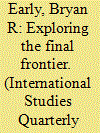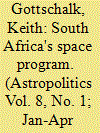|
|
|
Sort Order |
|
|
|
Items / Page
|
|
|
|
|
|
|
| Srl | Item |
| 1 |
ID:
130998


|
|
|
|
|
| Publication |
2014.
|
| Summary/Abstract |
While space capabilities were once concentrated among a handful of leading powers, an increasingly large number of states have gained access to them. As of 2007, 58 countries possessed dedicated civil space programs, 44 countries had placed nationally owned satellites into orbit, and 9 countries had achieved domestic space launch capabilities. To date, however, no systematic inquiries have ever been conducted into which countries acquire space capabilities and why. Within this paper, I develop an explanatory account that explores the capacity-based factors and political motivations that influence countries' acquisition of space capabilities. I test my hypotheses via a quantitative analysis of the factors affecting 143 countries' acquisition of civil space programs, satellite capabilities, and space launch capabilities from 1950 to 2002. My findings shed new light on the primary causes of the proliferation of civil space capabilities and yield a number of important policy implications
|
|
|
|
|
|
|
|
|
|
|
|
|
|
|
|
| 2 |
ID:
098141


|
|
|
|
|
| Publication |
2010.
|
| Summary/Abstract |
This article analyzes South Africa's space program, which can be divided into three chronological periods. First, was the age of amateurs that took place from 1947-1962. Second, from 1963-1993, South Africa's apartheid regime started various missile projects, including a secret military space launch program aimed at orbiting reconnaissance satellites. Under U.S. Government pressure, this was canceled before the first democratically-elected government came to power in South Africa, and the facilities for manufacturing and static testing the space launch vehicle were destroyed. But, South Africa maintains a nucleus of space heritage infrastructure, including a space launch range with telemetry capabilities, satellite testing, and integration facilities, and aerospace and software industrial sectors. Third, South Africa became a democracy in 1994, and established the legal and institutional infrastructure for a civil space program. Since then, South Africa has started to shape a new space policy, this time with greater public transparency.
|
|
|
|
|
|
|
|
|
|
|
|
|
|
|
|
|
|
|
|
|